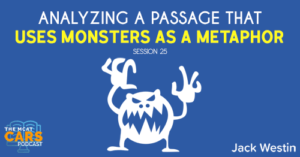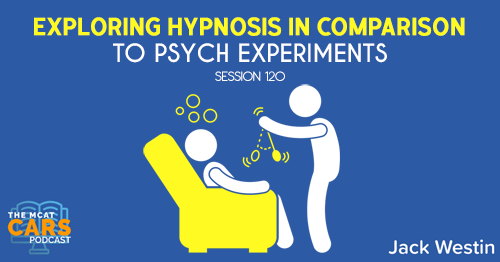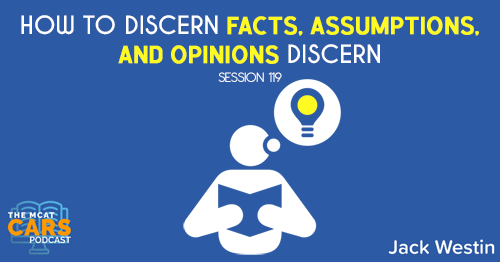Apple Podcasts | Google Podcasts

Session 25
This week, we have a great article about China, chimeras, some rabbits. Once again, we’re joined by Jack from Jack Westin. We break this passage down piece by piece, sentence by sentence – to help you rock your MCAT!
Please also find all our other podcasts on MedEd Media Network to help you along your journey to becoming a physician.
Link to article:
https://aeon.co/essays/there-be-monsters-from-cabinets-of-curiosity-to-demons-within
In 2003, a team of scientists in China managed to create embryos containing a mix of rabbit and human DNA. Most of the biological matter was human, while the rabbit DNA was present only in the mitochondria, the energy-generators of the cells. The aim was to try to find new ways of growing and harvesting the stem cells present in early human development, which were (and are) a promising avenue for medical study and treatment.
It wasn’t long, however, before controversy erupted over these so-called ‘chimeras’, as they were dubbed by some researchers. Were they human? What would happen if they were allowed to develop? Soon activists mobilised to restrict or quash the research. In 2005, the US outlawed patents on human embryos; in 2007, the Human-Animal Hybrid Prohibition Act was proposed in Congress (although ultimately it failed to pass into law). According to the bill, research into hybrids was said to compromise ‘human dignity and the integrity of the human species’. Pig heart transplants or the administration of animal-based insulin were acceptable, but the threat of potentially viable, cellular hybrids was too strong, despite the myriad social benefits it could yield.
These cells were very different in appearance to their mythological namesake, the chimeras of Greek mythology that possessed a lion’s head and body, a second goat’s head, and a serpent’s tail. Yet the rabbit-human embryos and the Ancient Greek image shared a deep similarity in the public imagination: they were both monsters.
The meaning of monstrosity has morphed dramatically over the course of history. Traditionally, monsters came from elsewhere: at the unknown edges of maps, from distant times and places. But as the bounds of the known Universe have expanded, the habitats of monsters shrunk back. The world is now so thoroughly charted that there seems to be little space left for indigenous monsters; instead, we import extraterrestrials and summon up artificial intelligence or cutting-edge technologies to act as the fearsome ‘Others’ for our books, TV series and films.
But monsters are restless things. Not only have they moved outward; they have also burrowed into our viscera, into our cells, into those ambivalent spaces within the human frame. Since the 19th century, humanity has been consciously developing techniques that can reshape the world in wonderful, dramatic, but often terrifying ways. We have created agricultural systems for taming nature, tools to tinker with the genetic building blocks of life, and machines that might soon be simulacra of ourselves. At the same time, transport and communication networks now connect the globe so completely that pandemics such as Zika and Ebola seem a bigger threat than ever. The modern age has also brought with it the deep isolation of individuals, apparently untethered to place, connecting through screens but divorced from nature. These changes have given rise to a new breed of monsters – ones that originate from the dystopian realities within the human mind.
[02:28] Paragraph 1, Sentence 1
In 2003, a team of scientists in China managed to create embryos containing a mix of rabbit and human DNA.
Jack says:
The author is setting the scene here.
[02:49] Paragraph 1, Sentence 2
Most of the biological matter was human, while the rabbit DNA was present only in the mitochondria, the energy-generators of the cells.
Jack says:
Visualize an Energizer rabbit. The first sentence is talking about science and students like DNA stuff. But if they feel like they don’t know it, they might start getting a little bit nervous. So let’s see what happens.
[03:44] Paragraph 1, Sentence 3
The aim was to try to find new ways of growing and harvesting the stem cells present in early human development, which were (and are) a promising avenue for medical study and treatment.
Jack says:
They’re telling us why they’re doing this.
[04:03] Paragraph 2, Sentence 1
It wasn’t long, however, before controversy erupted over these so-called ‘chimeras’, as they were dubbed by some researchers.
Jack says:
Chimera isn’t defined here yet and they’re just saying there’s a controversy over it.
[04:31] Paragraph 2, Sentences 2-3
Were they human? What would happen if they were allowed to develop?
Jack says:
Some questions are presented around the research.
[04:42] Paragraph 2, Sentences 2-3
Soon activists mobilised to restrict or quash the research.
Jack says:
People are trying to stop the research from going on.
[04:51] Paragraph 2, Sentence 4
In 2005, the US outlawed patents on human embryos; in 2007, the Human-Animal Hybrid Prohibition Act was proposed in Congress (although ultimately it failed to pass into law).
Jack says:
We’ve now moved from China to the U.S., talking about pact that was proposed but didn’t pass into law.
[05:17] Paragraph 2, Sentence 5
According to the bill, research into hybrids was said to compromise ‘human dignity and the integrity of the human species’.
Jack says:
We’re now getting into the understanding of where these politicians drew the line – going into the integrity of the human species.
[05:39] Paragraph 2, Sentence 6
Pig heart transplants or the administration of animal-based insulin were acceptable, but the threat of potentially viable, cellular hybrids was too strong, despite the myriad social benefits it could yield.
Jack says:
We’re given some examples of animal transplants and animal-based insulin saying that cellular hybrids were crossing the line. This is like an oxymoron. You do some of it, but then you can’t do the other things. As long as you know this paragraph is discussing there are potential ethical issues with this, then you’re going to be okay.
[06:26] Paragraph 3, Sentence 1
These cells were very different in appearance to their mythological namesake, the chimeras of Greek mythology that possessed a lion’s head and body, a second goat’s head, and a serpent’s tail.
Jack says:
They’re giving us where the name, “chimera” came from and maybe why people are scared of them.
[06:58] Paragraph 3, Sentence 2
Yet the rabbit-human embryos and the Ancient Greek image shared a deep similarity in the public imagination: they were both monsters.
Jack says:
We’re getting at the heart of what these politicians and other researchers were scared of. The author is setting up how people view these things. They’re associating these embryos and chimeras into something monstrous.
[07:29] Paragraph 4, Sentence 1
The meaning of monstrosity has morphed dramatically over the course of history.
Jack says:
It’s an interesting twist here as we were initially talking about chimeras and how people associate them with monsters. And now, we’re talking about the history of monsters.
[07:50] Paragraph 4, Sentence 2
Traditionally, monsters came from elsewhere: at the unknown edges of maps, from distant times and places.
Jack says:
They’re giving us a history of monsters and the fear of the unknown.
[08:05] Paragraph 4, Sentence 3
But as the bounds of the known Universe have expanded, the habitats of monsters shrunk back.
Jack says:
Monsters came from elsewhere or the unknown edges of the map. Now that we’ve mapped every place on our planet, there’s no place for the monsters to hide anymore.
[08:39] Paragraph 4, Sentence
The world is now so thoroughly charted that there seems to be little space left for indigenous monsters; instead, we import extraterrestrials and summon up artificial intelligence or cutting-edge technologies to act as the fearsome ‘Others’ for our books, TV series and films.
Jack says:
The author is saying we don’t have monsters to be scared of anymore since we’ve chartered everything on our planet. So now, as a species, are now fearing other things – things that are beyond this world. We see monsters in this “outer” kind of world. But once we understand our world, we seem to be designating monsters from the external.
[09:35] Paragraph 5, Sentences 1-2
But monsters are restless things. Not only have they moved outward; they have also burrowed into our viscera, into our cells, into those ambivalent spaces within the human frame.
Jack says:
We were talking about “outside of this planet.” So not only have these monsters moved outward but also inside us. They’ve burrowed into our viscera, organs, etc.
[10:41] Paragraph 5, Sentence 2
Since the 19th century, humanity has been consciously developing techniques that can reshape the world in wonderful, dramatic, but often terrifying ways.
Jack says:
The author talks about how we’re developing things in the 19th century that could be terrifying.
[11:02] Paragraph 5, Sentence 3
We have created agricultural systems for taming nature, tools to tinker with the genetic building blocks of life, and machines that might soon be simulacra of ourselves.
Jack says:
The author cites examples of techniques of what we’ve been building to reshape our world. This is a representation of ourselves. It’s setting up the fact that we create our own things. We are creators. We make stuff.
[11:52] Paragraph 5, Sentence 4
At the same time, transport and communication networks now connect the globe so completely that pandemics such as Zika and Ebola seem a bigger threat than ever.
Jack says:
We’re given some more context about human creations – transportation, communication networks, and some diseases are more easily spread because of that. And because we’re more aware of it, it seems to be a bigger threat. We don’t know where the author is going. But we do know that communication and networks have something to do with this outbreak.
[12:47] Paragraph 5, Sentence 5
The modern age has also brought with it the deep isolation of individuals, apparently untethered to place, connecting through screens but divorced from nature.
Jack says:
It’s telling us how technology is isolating us.
[13:10] Paragraph 5, Sentence 6
These changes have given rise to a new breed of monsters – ones that originate from the dystopian realities within the human mind.
Jack says:
The author is saying we are our own monsters inside our own heads. We’re creating and being isolated as well. This is where it comes back to the idea that we’re creating things that we’re afraid of.
[14:20] The Big Picture
We create stuff and these creations are our monsters. We’ve been creating things that are outwardly, and now, we going inward as well. We’re going to ourselves and things within our body. It’s this idea that we’re sometimes afraid of our own creations.
This could be hard for students because we started off with something they can easily understand. Then the passage becomes more abstract. And this abstraction is what throws students off. They’re not used to thinking about how these problems are more internally based.
Links:
Link to article: https://aeon.co/essays/there-be-monsters-from-cabinets-of-curiosity-to-demons-within
SEARCH SITE
SEARCH SITE
LISTEN FOR FREE











